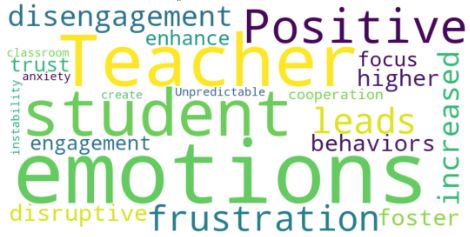Exploring the Influence of Teacher's Stress and Emotions on Student Behavior in Secondary Schools
Keywords:
Teacher Stress, Emotional Exhaustion, Student Behavior, Classroom Management, Teacher-Student RelationshipsAbstract
The focus of this study is on the intricate relationship between the stress of the teacher, the emotion of the teacher, and the behavior of the workers in secondary school classrooms, stressing the bidirectional relation (between) the emotional well-being of (the teacher) and the engagement of (the worker). Qualitative data from interviews with teachers and students are drawn on to investigate how emotional exhaustion, workload pressures, and the absence of institutional support prevent teacher regulation of emotion, and inhibit effective classroom management. What they found was that students can pick up on teacher stress, often based on what students perceive to be nonverbal cues, tone, and expressions, and those interpretations lead to the classroom behaviors of the students. Positive emotions by teachers develop trust, focus, and engagement, whereas frustration, inconsistency, and unpredictability engender student disengagement, increased disruptive behaviors, and strained relationships between teachers and students. These same emotional dynamics are catalyzed further by cultural factors; for instance, hierarchical power structures influence the context within which students respond to teacher stress. The systemic institutional support mechanisms are also lacking resulting in a cascade of emotional exhaustion followed by diminished classroom effectiveness. This study highlights the importance of emotional intelligence training, proactive classroom management strategies, and robust institutional support systems in a bid to reduce teacher stress and create a stable, positive learning environment. These results add to existing literature on the emotional well-being of teachers and provide practical suggestions to educational policymakers, administrators, and teacher training programs on addressing the emotional and psychological demands of teachers in today’s classrooms.
References
Yener Akman, “The Role of Classroom Management on Confidence in Teachers and Educational Stress,” Int. J. Contemp. Educ. Res., vol. 7, no. 1, 2020, doi: https://doi.org/10.33200/ijcer.687109.
N. J. Alasmari and A. S. A. Althaqafi, “Teachers’ practices of proactive and reactive classroom management strategies and the relationship to their self-efficacy,” https://doi.org/10.1177/13621688211046351, Sep. 2021, doi: 10.1177/13621688211046351.
A. Ball and D. Anderson-Butcher, “Understanding Teachers’ Perceptions of Student Support Systems in Relation to Teachers’ Stress,” Child. Sch., vol. 36, no. 4, pp. 221–229, Oct. 2014, doi: 10.1093/CS/CDU017.
Gartika Pandu Bhuana, “Teachers’ Encounter of Online Learning: Challenges and Support System,” J. English Educ. Teach., vol. 5, no. 1, 2021, doi: https://doi.org/10.33369/jeet.5.1.110-122.
V. Braun and V. Clarke, “Using thematic analysis in psychology,” Qual. Res. Psychol., vol. 3, no. 2, pp. 77–101, 2006, doi: 10.1191/1478088706QP063OA.
A. Brouwers and W. Tomic, “A longitudinal study of teacher burnout and perceived self-efficacy in classroom management,” Teach. Teach. Educ., vol. 16, no. 2, pp. 239–253, Feb. 2000, doi: 10.1016/S0742-051X(99)00057-8.
P. Clunies-Ross, E. Little, and M. Kienhuis, “Self‐reported and actual use of proactive and reactive classroom management strategies and their relationship with teacher stress and student behaviour,” Educ. Psychol., vol. 28, no. 6, pp. 693–710, Oct. 2008, doi: 10.1080/01443410802206700.
R. J. Collie, J. D. Shapka, and N. E. Perry, “School climate and social-emotional learning: Predicting teacher stress, job satisfaction, and teaching efficacy,” J. Educ. Psychol., vol. 104, no. 4, pp. 1189–1204, Nov. 2012, doi: 10.1037/A0029356.
H. de Boer, R. J. Bosker, and M. P. C. van der Werf, “Sustainability of Teacher Expectation Bias Effects on Long-Term Student Performance,” J. Educ. Psychol., vol. 102, no. 1, pp. 168–179, Feb. 2010, doi: 10.1037/A0017289.
C. Kyriacou, “Teacher Stress: Directions for future research,” Educ. Rev., vol. 53, no. 1, pp. 27–35, 2001, doi: 10.1080/00131910120033628.
J. J. Hakanen, A. B. Bakker, and W. B. Schaufeli, “Burnout and work engagement among teachers,” J. Sch. Psychol., vol. 43, no. 6, pp. 495–513, Jan. 2006, doi: 10.1016/J.JSP.2005.11.001.
A. Zoromski, S. W. Evans, J. S. Owens, A. Holdaway, and A. S. Royo Romero, “Middle School Teachers’ Perceptions and Use of Classroom Management Strategies and Associations With Student Behavior,” https://doi.org/10.1177/1063426620957624, vol. 29, no. 4, pp. 199–212, Sep. 2020, doi: 10.1177/1063426620957624.
S. M. Johnson, M. A. Kraft, and J. P. Papay, “How Context Matters in High-Need Schools: The Effects of Teachers’ Working Conditions on Their Professional Satisfaction and Their Students’ Achievement,” https://doi.org/10.1177/016146811211401004, vol. 114, no. 10, Oct. 2012, doi: 10.1177/016146811211401004.
S. Howard and B. Johnson, “Resilient teachers: Resisting stress and burnout,” Soc. Psychol. Educ., vol. 7, no. 4, pp. 399–420, Dec. 2004, doi: 10.1007/S11218-004-0975-0/METRICS.
K. A. Schonert-Reichl, “Social and Emotional Learning and Teachers,” Futur. Child., vol. 27, no. 1, pp. 137–155, 2017, doi: 10.1353/FOC.2017.0007.
R. Saunders, “The role of teacher emotions in change: Experiences, patterns and implications for professional development,” J. Educ. Chang., vol. 14, no. 3, pp. 303–333, Aug. 2013, doi: 10.1007/S10833-012-9195-0/METRICS.
A. C. Frenzel, T. Goetz, O. Lüdtke, R. Pekrun, and R. E. Sutton, “Emotional Transmission in the Classroom: Exploring the Relationship Between Teacher and Student Enjoyment,” J. Educ. Psychol., vol. 101, no. 3, pp. 705–716, Aug. 2009, doi: 10.1037/A0014695.
R. Pekrun, “The control-value theory of achievement emotions: Assumptions, corollaries, and implications for educational research and practice,” Educ. Psychol. Rev., vol. 18, no. 4, pp. 315–341, Dec. 2006, doi: 10.1007/S10648-006-9029-9/METRICS.
R. Pekrun and L. Linnenbrink-Garcia, “International handbook of emotions in education,” Int. Handb. Emot. Educ., pp. 1–698, Apr. 2014, doi: 10.4324/9780203148211/INTERNATIONAL-HANDBOOK-EMOTIONS-EDUCATION-REINHARD-PEKRUN-LISA-LINNENBRINK-GARCIA/ACCESSIBILITY-INFORMATION.
V. M. C. Tze, J. C. H. Li, and P. C. Parker, “A mediation analysis of emotions based on the control-value theory,” Curr. Psychol., vol. 42, no. 7, pp. 5392–5406, Mar. 2023, doi: 10.1007/S12144-021-01840-2/METRICS.
J. L. Taxer and A. C. Frenzel, “Facets of teachers’ emotional lives: A quantitative investigation of teachers’ genuine, faked, and hidden emotions,” Teach. Teach. Educ., vol. 49, pp. 78–88, Jul. 2015, doi: 10.1016/J.TATE.2015.03.003.
F. Koca, “Motivation to learn and teacher-student relationship,” J. Int. Educ. Leadersh., vol. 6, no. 2, 2016, [Online]. Available: https://files.eric.ed.gov/fulltext/EJ1135209.pdf
S. E. V. Gerda Hagenauer, Tina Hascher, “Teacher emotions in the classroom: associations with students’ engagement, classroom discipline and the interpersonal teacher-student relationship,” Eur. J. Psychol. Educ., vol. 30, pp. 385–403, 2015, doi: https://doi.org/10.1007/s10212-015-0250-0.
M. N. Wink, M. D. LaRusso, and R. L. Smith, “Teacher empathy and students with problem behaviors: Examining teachers’ perceptions, responses, relationships, and burnout,” Psychol. Sch., vol. 58, no. 8, pp. 1575–1596, Aug. 2021, doi: 10.1002/PITS.22516.
J. S. M. Robert J. Marzano, “The Key to Classroom Management,” Educational leadership: journal of the Department of Supervision and Curriculum Development, N.E.A. Accessed: Mar. 04, 2025. [Online]. Available: https://www.researchgate.net/publication/283749466_The_Key_to_Classroom_Management
A. J. Jeffrey, R. W. Auger, and J. L. Pepperell, “‘If We’re Ever in Trouble They’re Always There,’” https://doi.org/10.1086/671062, vol. 114, no. 1, pp. 100–117, Sep. 2013, doi: 10.1086/671062.
A. S. Eisenhart, M., Jurow, “Teaching qualitative research,” SAGE Handb. Qual. Res., vol. 4, pp. 669–714, 2011.
R. L. . Partin, “The classroom teacher’s survival guide : practical strategies, management techniques and reproducibles for new and experienced teachers,” 2013, Accessed: Mar. 04, 2025. [Online]. Available: https://books.google.com/books/about/The_Classroom_Teacher_s_Survival_Guide.html?id=bJaLOG3cGQ0C
P. H. Hinchey, “Becoming a Critical Educatior. Defingin a Classroom Identity.,” New York, pp. 3–168, 2004, Accessed: Mar. 04, 2025. [Online]. Available: https://books.google.com/books/about/Becoming_a_Critical_Educator.html?id=5jK7RfiKSu8C
P. W. Garner, L. K. Moses, and B. Waajid, “PROSPECTIVE TEACHERS’ AWARENESS AND EXPRESSION OF EMOTIONS: ASSOCIATIONS WITH PROPOSED STRATEGIES FOR BEHAVIORAL MANAGEMENT IN THE CLASSROOM,” Psychol. Sch., vol. 50, no. 5, pp. 471–488, May 2013, doi: 10.1002/PITS.21688.
Janneke A. de Ruiter, Astrid M.G. Poorthuis, and H. M. Y. Koomen, “Relevant classroom events for teachers: A study of student characteristics, student behaviors, and associated teacher emotions,” Teach. Teach. Educ., vol. 86, p. 102899, 2019, doi: https://doi.org/10.1016/j.tate.2019.102899.
A. Hargreaves, “The emotional practice of teaching,” Teach. Teach. Educ., vol. 14, no. 8, pp. 835–854, Nov. 1998, doi: 10.1016/S0742-051X(98)00025-0.
J. Liu, “Asian students’ classroom communication patterns in U. S.Universities: An emic perspective,” Am. J. Educ. Res., 2001, [Online]. Available: https://www.sciepub.com/reference/80934
R. V. Lindsey, J. D. Shroyer, H. Pashler, and M. C. Mozer, “Improving Students’ Long-Term Knowledge Retention Through Personalized Review,” https://doi.org/10.1177/0956797613504302, vol. 25, no. 3, pp. 639–647, Jan. 2014, doi: 10.1177/0956797613504302.

Downloads
Published
How to Cite
Issue
Section
License
Copyright (c) 2025 50SEA

This work is licensed under a Creative Commons Attribution 4.0 International License.




















